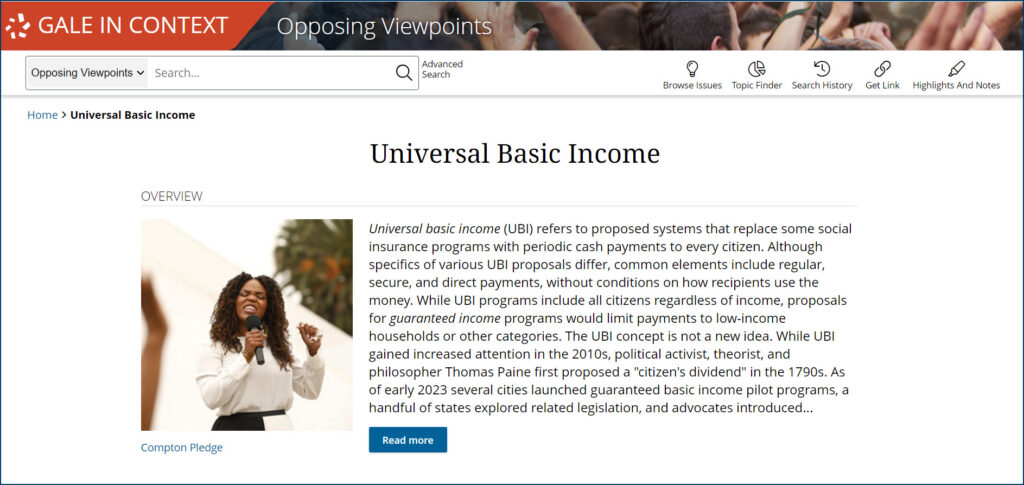| By Gale Staff |
The premise of universal basic income (UBI) is simple: Provide every citizen with regular, unconditional payments to ensure they have a degree of guaranteed financial security.
A 2019 study found that 43% of U.S. respondents support UBI, but the breakdown of this data reveals more intriguing insights.
Support is highest among younger adults aged 18–29, with 67% in favor—many of whom earn a median annual income between $55,000 and $85,800. This enthusiasm decreases with age, with 49% support among those aged 30–49, who typically earn $85,800 to $101,300, and just 40% among those aged 50–64, with a median income of $90,600 to $110,700.
As the gap between high and low earners widens, today’s students enter the workforce as the lowest-earning demographic. They face concerns about economic stability and the future of work in ways that older generations might not.
The universal basic income topic page available through Gale In Context: Opposing Viewpoints presents students with a spectrum of stances on UBI. They can engage with various multimedia resources, including interactive data visualizations and reference materials that provide quantitative evidence on topics like economic inequality and poverty levels. Students can also explore video content and opinion pieces for qualitative insights.
Introduce the topic using Gale’s trustworthy curated content to guide students as they examine their own beliefs and others’ perspectives.
Analyze the Economic Impact of UBI
In 2024, the Muindi Foundation reported that 59% of Americans are a single missed paycheck away from homelessness. An unexpected expense or sudden job loss can trigger a downward spiral—losing a home can mean losing a stable address, making it challenging to secure new employment. An eviction often restricts future rental options, while a repossessed vehicle can ruin credit scores, making it nearly impossible to secure loans or housing. Even a medical bill can cause untold damage to an individual’s financial future.
The cycle of poverty and homelessness can quickly become self-perpetuating, trapping individuals in a situation that’s far more expensive to escape than to prevent in the first place. Those who support a UBI believe it can end this cycle by creating a consistent financial safety net that keeps people afloat during tough times.
One notable real-world example that supports this idea is the “Bread for the City” project, which gave residents of the poorest parts of Washington, D.C., $5,500 to spend however they wished.
In the follow-up report, the Urban Institute found that “a majority of participants—54%—reported [catching up on] rent or mortgage payments. The second-most common use was for food and groceries, with some using the money to start small businesses or for transportation.” Proponents see this as evidence that UBI allows people to regain their financial footing before the worst-case scenario happens.
Critics, however, caution that while a guaranteed payment might ease immediate financial pressures, it does not address the systemic issues contributing to poverty.
As Heath Henderson pointed out in a 2023 article, “Cash can’t buy everything . . . Direct cash assistance does not combat the structural issues—such as discrimination, weak democratic governance, and unfair international trade practices—that cause poverty in the first place.”
Henderson and others with similar perspectives express that UBI provides short-term relief without tackling these root issues, thus falling short of providing a sustainable solution to lift people out of poverty. Some critics also point out that it could divert funding from policy changes needed for lasting economic equity, suggesting that targeted spending on education and affordable housing might be a more effective strategy.
Critical Thinking Questions for Students
- Supporters believe that UBI provides necessary, immediate financial stability, while critics warn it could shift focus away from structural reforms. Which approach is more effective for reducing poverty long-term, and why?
- Find examples in Gale In Context: Opposing Viewpoints of other countries or regions implementing UBI or similar programs. How do these international experiences shape your understanding of UBI’s potential impact in the United States?
Examine the Feasibility of Funding
Typical estimates place the cost of providing every American with a $1,000 monthly UBI payment between $3 and $4 trillion annually. Naturally, this raises concerns about whether the economic benefits are worth imposing an unsustainable burden on government budgets, potentially requiring significant tax increases or cuts to existing social programs.
However, some studies suggest that the financial requirements for UBI might be more manageable than critics claim.
Georgetown professor Karl Widerquist authored a study in 2018 that concluded, “Guaranteeing a universal basic income (UBI) that allows all Americans to live above the poverty line would have a cost equal to less than 3% of the nation’s gross domestic product (GDP),” approximately $539 billion per year. This estimate is significantly lower than many others—about one-sixth of common projections—and less than the current cost of entitlement programs like Social Security, Medicare, and Medicaid.
The discrepancy between estimates reflects each side’s assumptions about how UBI might be funded and implemented.
Supporters point out that funding a basic income would simplify the current welfare system, freeing up administrative costs and allowing UBI to coexist with or replace existing forms of assistance. Yet, even with this more optimistic projection, questions remain about the economic trade-offs required to make UBI a reality.
Some economists argue that reallocating funds from the existing $1.01 trillion currently spent on social programs might result in unintended consequences for those who rely on them most, such as individuals with disabilities or low-income families who need specialized support.
Others worry that it’s a fast track to driving up inflation, as the sudden economic boost would reduce the value of payments, necessitating future adjustments if we want to maintain purchasing power.
Financial services consultant Paul Boyce explains, “A UBI would essentially transfer wealth away from higher earners toward low earners. This spurs higher consumption . . . Rather than money going toward investment, it is going toward consumer goods. Instead of inflation occurring through a wide variety of areas, it is being concentrated.”
Critical Thinking Questions for Students
- In what ways could UBI influence inflation, and how might governments address the challenge of maintaining the purchasing power of a guaranteed income over time? What other economic policies might be needed alongside UBI to manage this risk?
- One argument against a UBI is that reallocating funds from existing welfare programs would negatively impact vulnerable populations who require more than the proposed monthly allotment provides. What alternative solutions could address these potential gaps?
Investigate How UBI Might Affect Employment and Entrepreneurship
In July 2024, a published study examined the effects of providing $1,000 in cash each month to 1,000 low-income individuals in Illinois and Texas over three years. The data indicated that, on average, the total household labor force hours decreased by 1.3 hours per week—the majority of which were spent on leisure—bringing the average work week to 30.28 hours.
Critics of UBI suggest that these results validate the argument that a guaranteed income means that individuals are less inclined to seek employment or work extra hours, resulting in a reduced labor force that slows economic growth. Providing financial relief, critics believe, would remove the urgency to find work, leading to a shift in how people prioritize their time.
Others feel that such a minimal decrease in work hours is not necessarily a negative consequence. The financial cushion provided by UBI can allow families to explore new opportunities, such as pursuing entrepreneurial ventures or dedicating more time to job searches without the immediate pressure to accept any available position.
The findings from the 2024 study also contain nuances that complicate a straightforward interpretation because using averages to assess the overall effect on household work hours can obscure important details.
For instance, in households where a family member lost a job, a decrease in work hours might reflect economic hardship rather than a lack of motivation. In other cases, financial relief might have allowed a family member to pause working temporarily to pursue education, provide childcare, or simply take care of one’s health, which are net positives for the well-being of America’s workforce.
Critical Thinking Questions for Students
- How should we think about the role of leisure time when evaluating the success of economic policies like UBI? What factors should be considered when determining whether time spent outside work is beneficial or detrimental?
- How might UBI influence the microeconomics of communities with high unemployment or underemployment? What might happen if the residents of these areas had consistent access to cash?
Prepare Students to Participate in Future Economic Policy
The topic of UBI is one that students should engage with today, as they will soon become the leaders and voters addressing the challenges of an evolving job market. Gale’s database tools support these discussions with diverse sources and expert analyses, encouraging them to explore the issue from all sides.
If you would like to provide your classroom with comprehensive research tools on UBI and other pressing issues, contact a local sales representative for more information about Gale In Context: Opposing Viewpoints.


